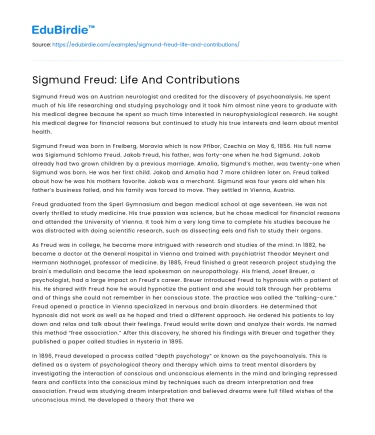Sigmund Freud was an Austrian neurologist and credited for the discovery of psychoanalysis. He spent much of his life researching and studying psychology and it took him almost nine years to graduate with his medical degree because he spent so much time interested in neurophysiological research. He sought his medical degree for financial reasons but continued to study his true interests and learn about mental health.
Sigmund Freud was born in Freiberg, Moravia which is now Příbor, Czechia on May 6, 1856. His full name was Sigismund Schlomo Freud. Jakob Freud, his father, was forty-one when he had Sigmund. Jakob already had two grown children by a previous marriage. Amalia, Sigmund’s mother, was twenty-one when Sigmund was born. He was her first child. Jakob and Amalia had 7 more children later on. Freud talked about how he was his mothers favorite. Jakob was a merchant. Sigmund was four years old when his father’s business failed, and his family was forced to move. They settled in Vienna, Austria.
Save your time!
We can take care of your essay
- Proper editing and formatting
- Free revision, title page, and bibliography
- Flexible prices and money-back guarantee
Freud graduated from the Sperl Gymnasium and began medical school at age seventeen. He was not overly thrilled to study medicine. His true passion was science, but he chose medical for financial reasons and attended the University of Vienna. It took him a very long time to complete his studies because he was distracted with doing scientific research, such as dissecting eels and fish to study their organs.
As Freud was in college, he became more intrigued with research and studies of the mind. In 1882, he became a doctor at the General Hospital in Vienna and trained with psychiatrist Theodor Meynert and Hermann Nothnagel, professor of medicine. By 1885, Freud finished a great research project studying the brain's medullain and became the lead spokesman on neuropathology. His friend, Josef Breuer, a psychologist, had a large impact on Freud’s career. Breuer introduced Freud to hypnosis with a patient of his. He shared with Freud how he would hypnotize the patient and she would talk through her problems and of things she could not remember in her conscious state. The practice was called the “talking-cure.” Freud opened a practice in Vienna specialized in nervous and brain disorders. He determined that hypnosis did not work as well as he hoped and tried a different approach. He ordered his patients to lay down and relax and talk about their feelings. Freud would write down and analyze their words. He named this method “free association.” After this discovery, he shared his findings with Breuer and together they published a paper called Studies in Hysteria in 1895.
In 1896, Freud developed a process called “depth psychology” or known as the psychoanalysis. This is defined as a system of psychological theory and therapy which aims to treat mental disorders by investigating the interaction of conscious and unconscious elements in the mind and bringing repressed fears and conflicts into the conscious mind by techniques such as dream interpretation and free association. Freud was studying dream interpretation and believed dreams were full filled wishes of the unconscious mind. He developed a theory that there were three agencies of the human personality called the id, ego, and superego. Id was primitive instincts such as sex and aggression. Ego was “self” and how it interacted with the world. Superego was defined as the ethical and moral part of the personality that created moral standards for the ego. He published a book called “Interpretation of Dreams in 1990. In 1901 he published “The Psychopathology of Everyday Life' which explained his theory that a slip of the tongued was not accidental, but it explained something meaningful about the person. “Three Contributions to the Sexual Theory” was published in 1905 which explained his theories on sexual drive and writes about how everything is centered from sexual drive beginning in infantry. He goes on the assign sexual meaning to everything.
Sigmund Freud made some of the most renown discoveries of his era. He was married to Martha Bernays in 1887 and they had six children. One of those six children, Anna, followed in Sigmund Freuds footsteps and had as much interest in psychology as he. She went on to become a famous psychologist herself. He left a deep footprint in the world of mental health. He taught about the unconscious mind, repression, and denial. It was because of him; mental disorders were no longer considered only “organic” diseases. Despite all his controversial theories and fame, he was a devoted man to his friends and family. He kept a small circle of friends, which he was ever loyal too and was deeply connected with his family. He enjoyed painting, art, music, and had a hobby of collecting mushrooms. He loved traveling and reading. He was a seeker of knowledge. Freud embraced his own discoveries and was eager to share them with the world. He was also intrigued with the works of his colleagues and embraced their work as well. After many years of smoking cigars, in 1923, Freud was diagnosed with squamous cell carcinoma of his palate. He went through over thirty mouth surgeries, removing parts of his jaw, over a sixteen-year span. During this period and through all his pain, he still refused to quit smoking which lead to his death in 1939 through euthanasia from a private physician. He was cremated, and his ashes were placed in an ancient Greek urn with that of his wife’s ashes.






 Stuck on your essay?
Stuck on your essay?

